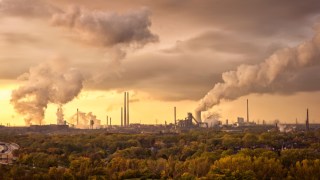By Glenn D. Rudebusch, David Wessel
The extent of future climate change largely depends on policy choices that the world makes today. Quantifying the link between policy actions and subsequent climate outcomes is crucial, but hard to do. Climate policy curves are a way to measure that link and enable comparison of alternative climate policies. This explainer draws from a Hutchins Center working paper, “Climate policy curves: Linking policy choices to climate outcomes.”
What exactly does a climate policy curve show?
Climate policy curves quantify the relationship between a carbon price and future increases in global temperatures. They incorporate two important relationships: the economic link from carbon prices to carbon dioxide (CO2) emissions, and the physical link from emissions to climate outcomes. A higher carbon price tends to reduce greenhouse gas emissions and atmospheric concentrations of CO2 and eventually curb the increase in global temperatures.
To restrain global warming, policymakers need to choose a combination of an initial carbon price and the pace at which it will rise over time. For instance, the analysis shows that an initial carbon price of $50 a ton that increases 6% a year limits the global temperature increase by 2100 to below 2% Celsius. An initial carbon price of $160 a ton that increases by 2% a year will achieve the same result. The first option pushes much of the burden of limiting climate change to future generations while the second puts more of the burden on today’s generation.
How would putting a price on carbon work?
Putting a price on CO2 emissions creates an incentive for producers and consumers to buy products and employ methods that emit less carbon. This price can be explicit, like a direct tax on the greenhouse gasses emitted when producing goods and services. But other climate policies can be viewed as placing an implicit price on carbon emissions, including a cap-and-trade system where the government sets a cap on emissions and creates a market for trading allowances to emit a certain amount. Producers that can most easily reduce emissions would tend to sell allowances to those for whom emission reduction would be more costly—an efficient outcome. A range of other policies, such as green subsidies, energy-efficiency regulations, and renewable-energy mandates, can also be broadly summarized in terms of an implicit price on each ton of CO2 emitted.
Where do the estimates in climate policy curves come from?
The authors of the paper calculate climate policy curves using an updated version of the Dynamic Integrated model of Climate and the Economy (DICE) that was developed by Nobel laureate William Nordhaus. The DICE model combines economic and climate science relationships to represent the trade-off between economic growth and efforts to reduce greenhouse gas emissions. It is widely used by policymakers and researchers to evaluate the potential economic impacts of different climate policies. By repeatedly simulating this model for different carbon price paths and observing the associated global warming, the authors trace out several climate policy curves.
Is there a lot of uncertainty about projections that run to the end of the century?
Yes. Uncertainty is a central issue for the design, implementation, and assessment of climate policy. Despite much climate science and climate economics research, substantial uncertainty remains about the key climate-economy interactions. In particular, a climate policy curve is subject to uncertainties about the effect carbon prices have on emissions and on the effect emissions have on rising global temperatures. The creators of climate policy curves show how varying the DICE model parameters creates a wide swath of possible curves. Thus, for example, limiting peak global warming to 2°C likely requires a carbon price of between $50 and $150 a ton coupled with a 4% subsequent annual price growth rate. However, this entire price range far exceeds the current global effective carbon price, which is less than $10.


